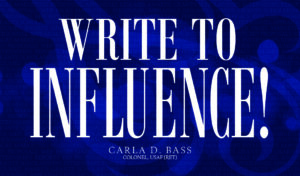Write to Influence!
Guest post on Ginger.com written by Carla D. Bass, Colonel, USAF (Ret) on April 26, 2018
Write to Influence! opens doors for promotion, fellowships, internships, scholarships, grants, career broadening opportunities and other competitive assignments, and more.
Have you ever read a paragraph and re-read it, unable to ascertain the author’s point? Of course, we all have. For the reader, wading through textual mud is frustrating and counterproductive. For the author, convoluted writing forfeits the opportunity to influence the reader and achieve the desired goal. For both parties, bureaucratic blather wastes valuable time.
Communication is constrained by time and space: the reader’s time (measured in seconds) and physical space allocated for your message. To exemplify the latter, some forms for annual performance reviews allocate as little as 1,000 spaces in which to convey your accomplishments. You must write powerfully to make each word count.
My battle cry is, “Powerful writing changes lives!” It opens doors to opportunity that would otherwise remain closed. You could be the best qualified for a job, promotion, or selective academic opportunity –hands down. But, if the competition is better at telling a story … presenting his/her credentials … you lose.
Powerful writing is also the lifeblood of private business, corporations, non-governmental organizations, and government agencies. It is essential for building public support for an issue, attracting talented job applicants, and marketing. Want to justify additional resources or, conversely, preclude cuts to existing budgets? A well-crafted, hard-hitting message often tips the scale in your favor.
“Write to Influence” entails a two-pronged approach, visualized as an inverted triangle. First, think strategically, think of the big picture to make your case. Second, hone your text to make each word count and every second of the reader’s time play to your advantage. By applying both approaches, the author achieves hard-hitting, focused, and compelling products. This article addresses strategies to make the case:
Number 1. Determine your goal – What’s the point?What do these two scenarios have in common? First, you stand before the glowering judge, who demands to know, “You did what?!” Second, your stressed boss, peeks at you from behind the desk and tersely exclaims, “I’m busy! What do you want?” Each requires a concise, logical, fact-based response. For an author, the corresponding questions are, “Why are you knocking on the audience’s door? What do you want to convey?” Capture this in a single paragraph and use it as a north star to vector the development of your product.
Number 2. Chart the course – Lead the reader. Poof … You are now a tour guide! Whether composing fact or fiction, the author must lead the audience to that desired conclusion. Begin with an outline that keeps the story on track, benefiting the author and the audience. Identify major points of the story-line, ensuring the message has a beginning, a middle, and the all-important end. Then, augment the outline with hard-hitting facts as the message comes into focus. Use signposts to guide the reader. I’m referring to words such as first, second, and third. These tell the reader, “OK, we’re moving to a different point. Please change gears.” Signposts are effective tools, especially when conveying a lengthy or complex message.
Number 3. Think around the corner – Address readers’ reactions. As you write, examine your message from the reader’s perspective. What questions or concerns might your “destination” paragraph prompt? If you were the recipient, what would you like to know? Develop your outline and subsequent text to address that information. Then, review your draft. Does it emphasize the proper points? Does the text flow logically, provide a solid argument, and answer the questions you so astutely anticipated? If your reader must advocate your case to higher authorities (e.g., an agent approaching a publisher), have you provided sufficient ammunition?
Number 4. Game on! – Hook that reader! Craft the opening lines to grab the reader’s attention. By the way, the conclusion is equally critical as it influences the reader’s final … and often lasting … impression of your work. Think in terms of the opening and closing arguments in court or, if you prefer, the appetizer and dessert of a fabulous, gourmet meal. Bottom line … leverage the opening and closing to your advantage.
Number 5. Make that story pop! – Add detail to quantify. Just as spices add a nuanced flavor to that gourmet meal, detail adds depth, dimension, and context to the story. They equip the reader with a mental yardstick to better grasp your message. Include solid facts and quantify to make your case. Describe how big, what duration, amount of hours invested, number of participants, how many, what percentage, etc. Here is an opening hook that quantifies the context. Does this encourage you to read further? For the first time in the five years that the report has been produced…
Number 6. Close the gates – Don’t lose the reader. Remember your role as tour guide; you must lead the reader directly to the conclusion without detour. Secure the gates. How? Avoid items that divert the reader’s attention from your message. Examples include: Strange wording(e.g., professional jargon) and poorly defined terms; errors in punctuation, spelling, and capitalization; partially made points that prompt questions, “How many? How long? Who signed? What happened as a result?”; gibberish that causes the reader to respond, “Huh?” Exemplifying the latter, consider this bullet from a resume: Consistently been proactively engaged with the corporation and delivering reusable methodologies, embraced philosophies, and insight into the culture of his project. Yep, lost the reader!
About the Author: Carla D Bass, Colonel, USAF (Retired), authored the award-winning book, “Write to Influence!” During her 30-year career, she taught professional writing to thousands of people and now offers engaging workshops tailored for students from high school through graduate school and people already in the workforce.


